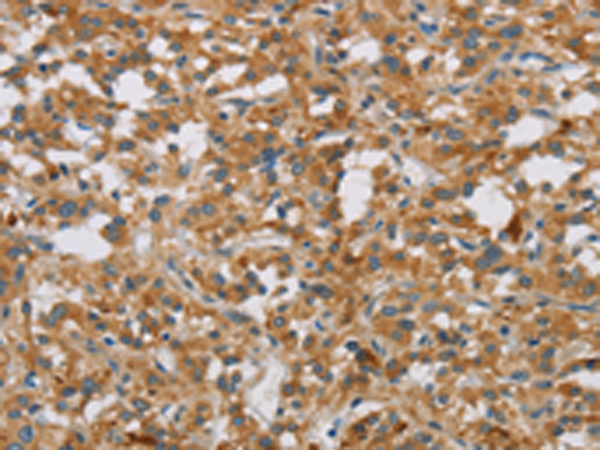

| WB | 咨询技术 | Human,Mouse,Rat |
| IF | 咨询技术 | Human,Mouse,Rat |
| IHC | 1/100-1/300 | Human,Mouse,Rat |
| ICC | 技术咨询 | Human,Mouse,Rat |
| FCM | 咨询技术 | Human,Mouse,Rat |
| Elisa | 1/5000-1/10000 | Human,Mouse,Rat |
| Aliases | DBM |
| WB Predicted band size | 69 kDa |
| Host/Isotype | Rabbit IgG |
| Antibody Type | Primary antibody |
| Storage | Store at 4°C short term. Aliquot and store at -20°C long term. Avoid freeze/thaw cycles. |
| Species Reactivity | Human, Mouse |
| Immunogen | Fusion protein of human DBH |
| Formulation | Purified antibody in PBS with 0.05% sodium azide and 50% glycerol. |
+ +
以下是关于DNAJB9抗体的3篇参考文献,涵盖其在不同疾病诊断和机制研究中的应用:
---
1. **文献名称**: *DNAJB9 is a specific diagnostic marker for fibrillary glomerulonephritis and highlights mitochondrial alterations*
**作者**: Satoshi H., et al.
**摘要**: 该研究通过免疫组化分析发现,DNAJB9抗体在纤维性肾小球肾炎(FGN)患者肾组织中特异性高表达,而其他肾小球疾病中未见此现象。研究认为DNAJB9可作为FGN的诊断生物标志物,并提示其可能通过线粒体功能障碍参与疾病进展。
---
2. **文献名称**: *DNAJB9 immunohistochemistry improves diagnostic accuracy in immunoglobulin-associated kidney diseases*
**作者**: Liu Z., et al.
**摘要**: 本文比较了DNAJB9抗体检测与刚果红染色在免疫球蛋白相关肾病(如淀粉样变性)中的诊断效能。结果显示,DNAJB9抗体在区分非淀粉样纤维性肾病中具有高敏感性和特异性,可作为辅助诊断工具。
---
3. **文献名称**: *DNAJB9 expression differentiates subtypes of proliferative glomerulonephritis with monoclonal immunoglobulin deposits*
**作者**: Andeen N.K., et al.
**摘要**: 研究利用DNAJB9抗体分析不同亚型的单克隆免疫球蛋白沉积性肾小球肾炎,发现其表达模式与疾病亚型及预后相关。DNAJB9阴性病例更易进展为肾功能衰竭,提示其临床分型价值。
---
**备注**:若需补充更多文献或扩展具体研究细节,可进一步检索PubMed或Scopus数据库,关键词建议:“DNAJB9 antibody”、“fibrillary glomerulonephritis”、“biomarker”。
The DNAJB9 antibody targets the DNAJB9 protein, a member of the Hsp40/DnaJ family of molecular chaperones. DNAJB9. also known as ERdj4 or MDG1. functions as a co-chaperone for Hsp70 proteins, aiding in protein folding, quality control, and degradation within the endoplasmic reticulum (ER). It plays a critical role in the unfolded protein response (UPR), helping to alleviate ER stress by binding misfolded proteins and directing them toward ER-associated degradation (ERAD). Dysregulation of DNAJB9 has been implicated in diseases involving protein misfolding, including certain cancers, fibrotic disorders, and neurodegenerative conditions.
In diagnostic contexts, DNAJB9 antibodies are particularly valuable for identifying fibrillary glomerulonephritis (FGN), a rare kidney disease characterized by abnormal glomerular deposits. DNAJB9 immunohistochemistry (IHC) has emerged as a specific marker for FGN, distinguishing it from other amyloidosis or fibrillary-like kidney disorders. Research applications include studying ER stress pathways, tumor progression (e.g., roles in TGF-β signaling and epithelial-mesenchymal transition), and mechanisms underlying fibrosis. Commercially available DNAJB9 antibodies are optimized for techniques like IHC, Western blotting (WB), and immunofluorescence (IF), enabling both clinical diagnostics and molecular studies. Its dual role in proteostasis and disease pathways makes DNAJB9 a protein of growing interest in translational research.
×